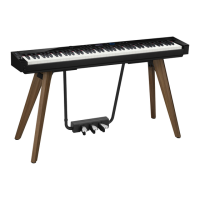Using the Arpeggiator
EN-78
3.
Touch the top or bottom of the touch ring to select the setting you want to
change.
• The table below shows the setting items, values and descriptions of each.
*1 See “Arpeggiator List” (page EN-184).
*2 Items that are automatically set when this setting is “On” include the following:
• The key range (the Split Point between Upper and Lower Parts) in which the Arpeggiator plays is
set automatically. For this reason, depending on the keys pressed, the Arpeggiator may not play.
• Enabling/disabling the use of the pedal for each part (Upper 1/Upper 2/Lower) is set automatically.
The applicable pedals are those connected to the PEDAL UNIT jack and those connected to the
EXPRESSION/ASSIGNABLE jack (only when “Damper” is selected as the pedal’s function).
*3 Even if these settings are “Off”, if “Recommended Setup” is “On”, the recommended settings are
given priority and applied. For details on recommended settings for each pattern, see “Arpeggiator
List” (page EN-184).
4.
Change the value of the selected item.
• Trace the touch ring to change the desired value.
5.
Repeat Steps 3 and 4 as necessary.
• The arpeggio speed depends on the tempo setting. For more information, see “Changing the
Metronome Settings (Tempo, Beat, Pattern, etc.)” (page EN-74).
• You can assign turning the Arpeggiator on/off to an EX button and turning the Arpeggio Hold on/off
to an EX button or a pedal connected to the EXPRESSION/ASSIGNABLE jack. For more
information, see “Using the EX Buttons” (page EN-67) and “Using Pedals” (page EN-62).
• Assigning “Arpeg Note Len” to the CONTROL button allows you to change the length of notes in
some Arpeggiator patterns. For more information, see “Selecting the Function Assigned to the
CONTROL Button” (page EN-69).
Setting item Values Description
Pattern
*1
Selects the pattern the Arpeggiator will play.
Recommended Setup On, Off
*2
When “On”, the Digital Piano automatically
applies the recommended tones and settings for
the Arpeggiator’s pattern whenever you switch
the Arpeggiator from Off to On or whenever you
switch to “Pattern” while the Arpeggiator is on.
Arpeggio Hold On, Off
*3
Toggles Arpeggio Hold On/Off. When “On”, the
arpeggio will continue to play even after you lift
your finger from the keys.
Upper1 Part
Upper2 Part
Lower Part
On, Off
*3
Selects whether the Arpeggiator will play (On) or
not play (Off) in the Upper 1, Upper 2, or Lower
Parts.

